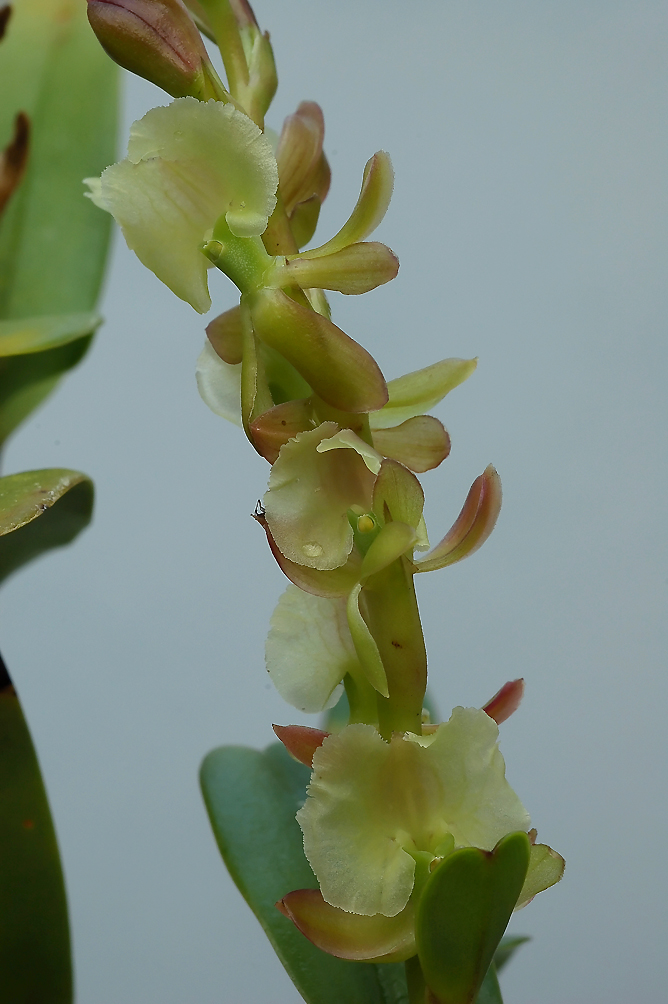

Epidendrum sp [E usurpator Karremans ined] GROUP Spathiger SUBGROUP Coriifolium
Photo by © Pieter C. Brouwer and his Nature Photo Website
TYPE Drawing by © Jimenez, Hágsater & E.Santiago and The AMO Herbario Website







Common Name
Flower Size 1" [2.5 cm]
Found in Costa Rica in open old oak forests at elevations of 700 to 1900 meters as a small to medium sized, warm to cool growing epiphyte with a simple, erect, basally terete, laterally compressed, cane-like stem enveloped completely by well spaced, tubular, striated sheaths and carrying 4 to 10, all along the stem, the lower and uppermost smaller, narrowly elliptic, retuse to bilobed apically leaves that blooms in summer through fall and winter on an apical, racemose, disitchous, secund, erect, sinuous, laterally compressed, 6.4 to 10.4" [16 to 26 cm] long, 5 to 7 flowered inflorescence with elongate, conduplicate bracts and arising on a mature stem and carrying simultaneously opening, non-resupinate, nocturnally fragrant flowers.
CAUTION This presently undescribed species is native to the central valleys and the Cordillera de Tilarán and has been confused with Epidendrum bilobatum. The species above has shorter narrow elliptic leaves 3.0 to 7.2 x 1.2 to 2.4 cm, 2-3:1, sepals 10 to 19 mm long, and the lip 9 to 11.8 x 15 to 17.5 mm, clearly wider than long.
" Epidendrum sp belongs to the GROUP Spathiger SUBGROUP Coriifolium characterized by the sympodial growth habit, distichous inflorescence with large, conduplicate bracts, fleshy green secund flowers with narrow petals and reniform lip. The species is distinguished by the subcaespitose habit, stem with 4 to 10 coriaceous, flat, narrowly elliptic leaves up to 4.4" [11 cm] long, and most notably, the erect, distichous, ancipitose inflorescence with non-imbricating, non-acuminate bracts, and the distichous, simultaneous apple-green colored flowers. The characteristic interspaced floral bracts .32 to .4" [8 to 10 mm] long are reminiscent of Epidendrum caluerorum Hágsater, but that species has shorter stems, 3.2 to 8" [8 to 20 cm] long with 3 to 6 leaves, the peduncle of the inflorescence with 1 to 7 imbricating bracts, the lip subtrapezoid, truncate at the base instead of cordate. Epidendrum belloi Hágsater has a similar number of leaves per stem, but the plants of that species are very large, 18 to 26.4" [45 to 66 cm] tall, the inflorescence has long, triangular bracts and a cordiform lip." Hagsater etal 2007
" NOTE : In their publication of Epidendrum bilobatum, Jiménez & Hágsater (2007), the description is a combination of two species, the real E bilobatum and this population illustrated above, found in the central Valleys of Costa Rica and the Cordillera de Tilarán, which will be published elsewhere, and treated above as Epidendrum sp. The illustration provided here and there(Tilarán, Hágsater 7094, AMO!) corresponds to that undescribed species; the list of specimens in the Appendix, page III, correspond to that species
Pers Comm. Eric Hagsater states that he has the impression that the photo above is the same species as his description above but the petals and the erose lip margin differs.
Synonyms
References W3 Tropicos, Kew Monocot list , IPNI ; Icones Orchidacearum 9 Plate 914 Hagsater 2007 drawing fide to this species Epi sp; Icones Orchidacearum 18(2) Plate 1859 Hagsater & Jimenez 2021 see recognition section
--------------------------------------------------------------------------------------------------------------------------